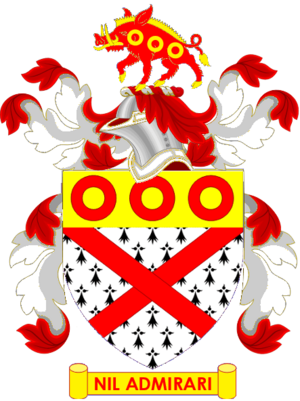Gerald Fitzgibbon facts for kids
Quick facts for kids
Gerald Fitzgibbon
|
|
|---|---|
| Judge of the Supreme Court of Ireland | |
| In office 11 March 1924 – 23 July 1938 |
|
| Nominated by | Government of Ireland |
| Appointed by | Tim Healy |
| Teachta Dála | |
| In office May 1921 – August 1923 |
|
| Constituency | Dublin University |
| Personal details | |
| Born | 8 October 1866 Dublin, Ireland |
| Died | 6 December 1942 (aged 76) Dublin, Ireland |
| Education | Clifton College |
| Alma mater | |
Gerald Fitzgibbon (born October 8, 1866 – died December 6, 1942) was an important Irish judge. He served as a Judge of the Supreme Court from 1924 to 1938. Before that, he was a Teachta Dála (TD), which is a member of the Irish Parliament. He represented the Dublin University area from 1921 to 1923.
Contents
A Family of Lawyers
Gerald Fitzgibbon came from a very well-known family of lawyers. His grandfather, also named Gerald Fitzgibbon, was a Queen's Counsel (a senior lawyer) and a Master in Chancery (a type of judge). His father, also named Gerald Fitzgibbon, was a Lord Justice in the Irish Court of Appeal before Ireland became independent.
His father, along with two other judges, was famous for making the Court of Appeal a respected court. Their decisions are still studied today. Gerald Fitzgibbon's mother was the granddaughter of Francis Alexander FitzGerald, who was a Baron of the Court of Exchequer. This shows that legal work ran in the family!
Early Life and School Days
Gerald Fitzgibbon was born in Dublin in 1866. His family belonged to the Church of Ireland, which is an Anglican church. He was the oldest son of Gerald Fitzgibbon and Margaret Anne Fitzgerald.
He went to school at Clifton College in Bristol, England. After that, he studied at Trinity College Dublin, where he earned his Bachelor of Arts degree. In 1887, he became a lawyer, which is called being "called to the Irish Bar". He worked as a lawyer in the Munster area. Later, in 1908, he became a King's Counsel, a very senior type of lawyer. In 1912, he became a Bencher of the King's Inns, which is a group that governs lawyers in Ireland.
His Time in Politics
In 1921, Gerald Fitzgibbon was elected to the House of Commons of Southern Ireland. This happened without anyone running against him. He represented the Dublin University area. He was an Independent Unionist, meaning he supported Ireland remaining part of the United Kingdom.
He even acted as the Speaker (the person who leads the meetings) at its only session. Because he was a Unionist, he did not take part in the Second Dáil, which was the parliament of the Irish Republic. However, he was re-elected for the same area in the 1922 Irish general election. This made him a member of the Third Dáil. He decided not to run for election in 1923.
Becoming a Supreme Court Judge
In 1924, many senior judges from the old legal system had to retire. This meant new judges were needed for the newly formed Supreme Court of the Irish Free State. Hugh Kennedy, who was the new Chief Justice of the Irish Free State, suggested Fitzgibbon for a judge position.
Kennedy chose Fitzgibbon because of his strong legal skills. This was interesting because they had very different political views. Kennedy was a strong supporter of Irish independence, while Fitzgibbon was more cautious.
Disagreements with Chief Justice Kennedy
Chief Justice Kennedy soon found that working with Fitzgibbon was difficult. Their disagreements grew over time. Even though Fitzgibbon was a Protestant Unionist, his friends said he wasn't against the new Irish Free State. However, he seemed to become unhappy with some of the changes happening in the country. By 1929, it was said that he and Chief Justice Kennedy did not trust each other.
Their disagreements became very clear in 1935 during a court case. Fitzgibbon was part of the majority decision that ruled that the Constitution of the Irish Free State allowed for basic human rights to be suspended under certain conditions. Chief Justice Kennedy strongly disagreed with this decision.
In another case in 1934, called Re Westby, the Supreme Court, led by Fitzgibbon, overturned Kennedy's decision. The case was about whether a young boy, who was a ward of the court (meaning the court was responsible for him), should be educated in Ireland or at a school in England. Kennedy wanted him educated in Ireland, but Fitzgibbon's court decided differently. Kennedy felt this was a personal attack on him.
Later Years as a Judge
Gerald Fitzgibbon showed some interest in the new Constitution of Ireland when it was being created in 1937. He gave ideas on how the President of Ireland could ask the Supreme Court to review a new law before it was passed.
Despite being unhappy in his job, he stayed on the Supreme Court of Ireland until he reached the retirement age in 1938. Chief Justice Kennedy believed that Fitzgibbon stayed because his pension (retirement money) arrangements were not very good. Fitzgibbon felt he was treated unfairly by the Government regarding his pension. He had to retire nine months before he could get his full pension, so he only received about 42% of his salary.
Family Coat of Arms
 |
|

